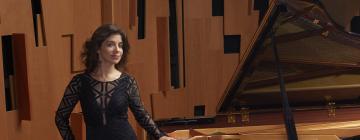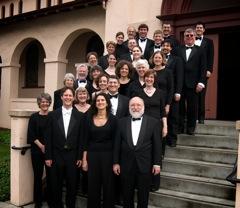
Early-music groups delight in throwing back the veil of history and bringing you another great composer you have never heard of (or never heard much of). So if you’re looking around at the holiday concerts on offer in the Bay Area this season and thinking “Same old, same old,” you might want to drop in on the California Bach Society the first week of December, as it presents seasonal themed music by Johann Rosenmüller, with the participation of the great, local wind-band The Whole Noyse.
Stay with me here. Rosenmüller was actually a fairly prominent 17th-century German composer whose music has been recorded and played by a number of early-music groups over the past 20 years. The featured piece on the CBS concert, the so-called Weihnachtshistorie (Story of the Nativity) can be heard on a 2004 release by Cantus Cölln and Concerto Paladino (Harmonia Mundi Fr).
Rosenmüller enjoyed a great education at a time when those things mattered, attending the University of Leipzig. He was hired on at the Thomasschule as assistant to the cantor, with whom he probably continued his musical studies. A promising career was cut short when he was suddenly dismissed for “improper behavior” with the choir boys. He fled to Venice, where he played trombone at the Cathedral of St. Mark and soon established himself as a composer there.
The Weihnachtshistorie is not actually as advertised. It’s a cantatalike setting of the Gospel reading for Christmas Day (“And there were shepherds abiding in the fields ...,” Luke, chapter 2), followed by a series of motets on the Gospel stories, which were compiled by Konrad Junghanel for the Cantus Cölln recording. But what makes it so great, and indeed what makes the concert likely to be so cool, is that Rosenmüller, like the great Heinrich Schütz before him, learned the Venetian church style and got really good at it. And that means lots of seriously virtuosic brass writing, full-throated choruses sung by double choirs singing antiphonally from different parts of the church, and the full, sumptuous splendor that Venice was famous for.
That’s where The Whole Noyse comes in. You’ve probably run across that name a few times in the “pages” of Classical Voice. Founded by cornettist Stephen Escher, it’s the main original-instrument ensemble in the Bay Area and one of the best in the country. It plays all over the U.S. and Canada, especially when there’s a big Venetian piece to do — like Monteverdi’s Vespers of 1610, which they’ve played more than 30 times this year (because of its 400th anniversary.) Escher describes his instrument as:
... a hybrid of brass and woodwind instruments. Unfortunately its type died out completely — there is no modern instrument. My instrument is made of boxwood, wrapped in leather, and has a very small, detachable, cup-shaped mouthpiece made of animal horn. The cornetti functioned as the top voices of the professional brass ensemble of the Renaissance and early Baroque. Its heyday was probably in the early 17th century, when it was featured by composers such as Schütz, Gabrieli, Monteverdi, and Rosenmüller.
Escher plays almost continually through this piece — you have to have tremendous chops to get through an hour’s entertainment on the cornett, one of the world’s most difficult wind instruments. But then again, what’s great about the cornett, and 17th-century music in general, is that you can have your cake and eat it, too. The big moments are never so shouty that you feel overwhelmed and distanced from the music. If the cornett were a trumpet, you might get tired of its being featured consistently; but it’s not and you won’t.

